Dying to know the difference between sewing, crochet, knitting, and embroidery? As someone who does ALL four, I will explain and illustrate the key differences between these four popular handicrafts including pros, cons, and applications of each.
Sewing, Crochet, Knitting, and Embroidery are all considered “Needle Arts”, but they each have vastly different purposes and results.
While sewing and embroidery usually utilize thread, crochet and knitting often work with yarn. But that’s not all!
In this article I will give you an overview of each needle art including a description, photos of what it looks like, examples of the specific tools used, and more.
So read on if you’re ready to “unravel” the mystery!
This post may contain affiliate links. Read the full disclosure here.
Quick Comparison Chart
For those of you who just want a quick glance chart, here it is!
| Use | By Hand | By Machine | Needles | Hooks | |
| Sewing | Joins Fabric | X | X | X | |
| Crochet | Creates Fabric | X | X | ||
| Knitting | Creates Fabric | X | X | X | |
| Embroidery | Embellishes Fabric | X | X | X |
This chart quickly illustrates the basic uses and features of sewing, crochet, knitting, and embroidery. They each can be done by hand, and crochet cannot be done by machine. They all use a type of needle except crochet uses a hook. (Knitting needles do not have holes.)
Here is a “Pin-able” version so you can save it to Pinterest to reference later.
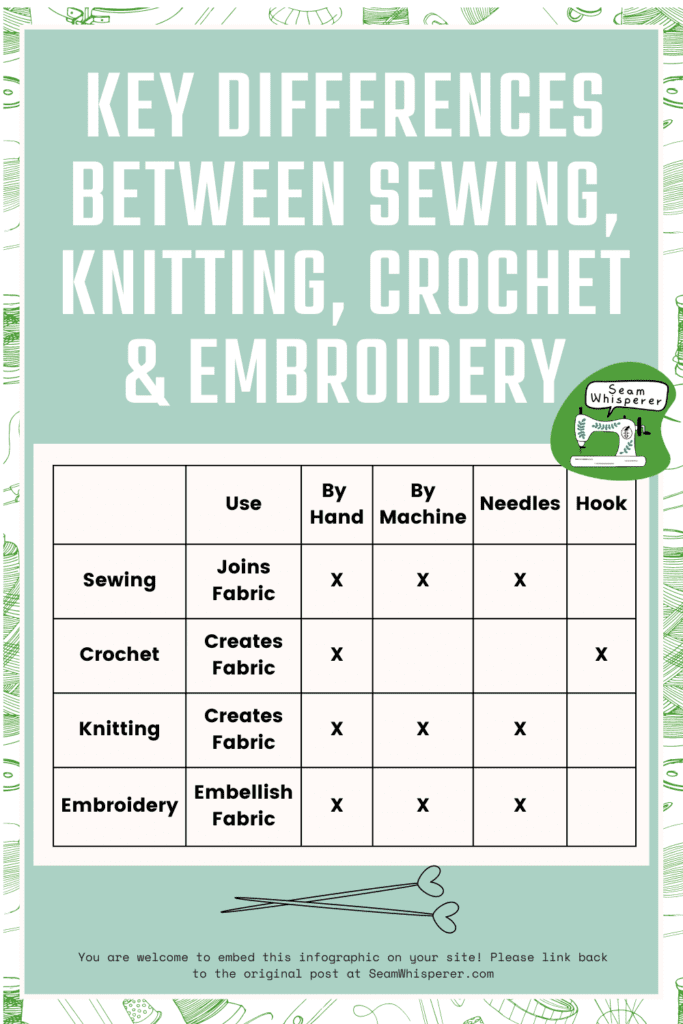
Now, lets go into even more detail…
What Is Sewing?
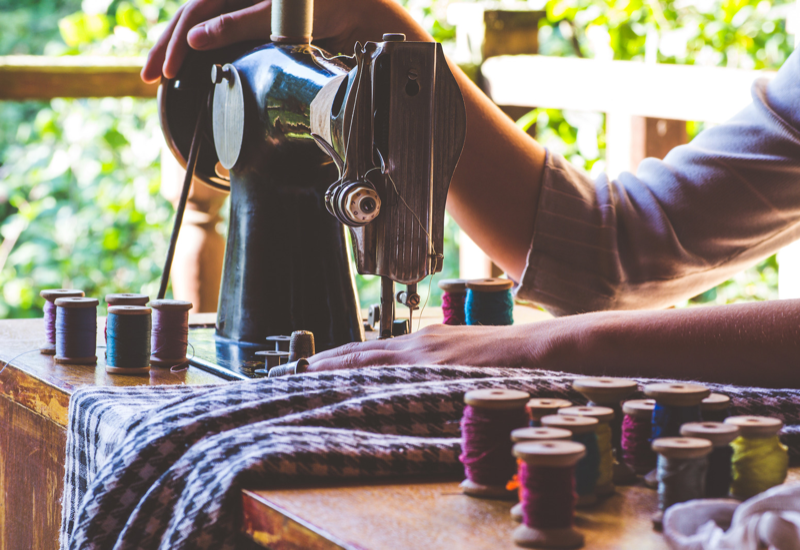
Sewing is when you use a needle and thread to join materials (usually fabrics) together to create textile objects such as clothing, curtains, bags, or linens.
Sewing (sometimes called stitching) can be done by hand with a hand sewing needle, or by machine. Hand sewing needles and machine sewing needles are designed with a small hole (referred to as the eye of the needle) through which a thread is threaded.
The needle is then pierced through the material, and the thread is pulled through in a particular manner to create stitches. When sewing on a machine, there Is an upper thread and a lower thread that loop together to create stitches. When hand sewing, there is only one thread.
Applications Of Sewing
Whether you hand sew or use a sewing machine, the main purpose is to join fabric shapes, hem edges to keep them from fraying, and manipulate fabric to make textures such as gathers, pleats, or folds.
Sewing patterns are used to make 3 dimensional sewn items by cutting out particular shapes from fabric, and sewing them together.
For example, a very basic skirt is made by cutting out a large rectangle, sewing the two short ends together into a loop, and somehow cinching the top edge to make a waistband.
Sewing is the ideal way to mend rips in almost any textile product.
Common Sewing Tools
Common tools used while sewing include:
- A Sewing Machine
- Hand Sewing Needle
- Thread
- Seam Ripper
Pros Of Sewing
- A hand sewing kit is an essential emergency kit item
- Learning to sew makes altering, mending, or creating your own clothing easy and fun.
- Hand sewing is a fast way to sew on a loose button
- Sewing allows you to repair your broken household items instead of throwing them away such as ripped pillows, towels, blankets, or curtains
- Sewing your own home décor can save you a lot of money
- If you make a mistake while sewing, you can unpick the seam and try again. It is fast and somewhat forgiving (unless you have cut the fabric wrong!)
Cons of Sewing
- To sew by hand or by machine, you have to be able to thread a needle. If you have poor eyesight or hand trouble keeping your hands steady, it can be hard to insert the thread into the needle. (However, there are methods to make this easier)
- Machine sewing is not a particularly mobile hobby, since it uses a large machine that needs to be plugged in.
- Sewing machines are more expensive than some other tools mentioned in this article
What is Knitting?

Knitting creates a long piece of material from a continuous strand of yarn wrapped together in loops, row by row on your knitting needles. Two needles are used while hand knitting, and the loops are passed from one needle to another as you work.
Knitting can be done by hand or machine, in fact you can even knit with your arms as the needles! (This is call arm knitting, and makes huge chunky blankets or scarves.)
Applications Of Knitting
Knitted textiles have stretch to them, which makes them popular for clothing items. Common t shirts are made with knitted fabrics, as well as basically all other kinds of clothing you can imagine that is stretchy.
Knitting is also a great way to make yarn hats and scarves. I fondly remember a pair of knitted leg warmers my sister made for me while we were in high school…
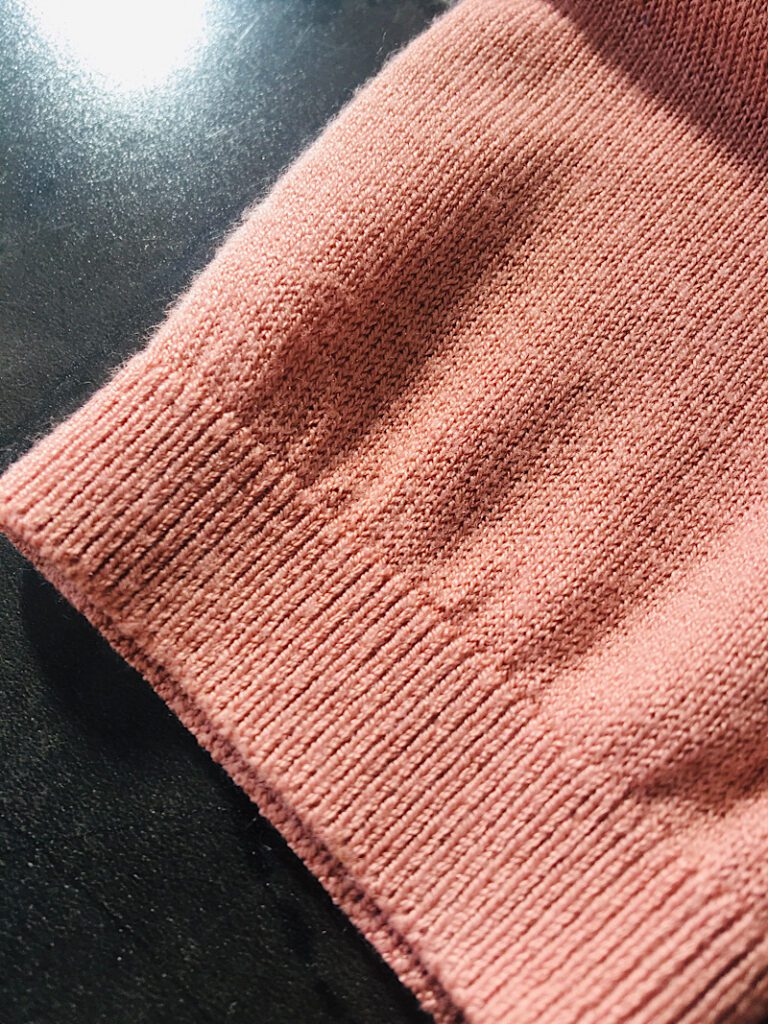
Common Knitting Tools
- Knitting needles
- Yarn
Pros of Knitting
- Knitting can be taken with you! All you need are your two needles and yarn.
- Knitted fabric does not fray, which means it doesn’t need to be hemmed
- Knitted fabrics are stretchy
- Knitting can be done by machine or by hand
Cons of Knitting
- Hand knitting requires decent eye sight to be able to see the tiny holes where you needle must be inserted into next.
- Because knitting uses one continuous strand of yarn, if you notice you made a mistake, you have to undo all your work to correct it.
What is Crochet?

Crochet is a technique of making textiles and fabrics with a hook that chains together loops of continuous yarn or floss.
When you crochet, you hold the hook in your dominant hand while holding the tail of the yarn in the other. You insert the hooked end of the hook into the work, loop thread around it, and pull it through to interlock the yarn and make your design.
Crochet can NOT be done by machine, it can only be done by hand. Any object that has been crocheted, has been hand made.
Applications of Crochet
Crochet is a popular way to make clothing items such as hats, mittens, sweaters, and even blouses or dresses. Crocheted blankets, afghans and rugs come in all sorts of patterns and designs as well.
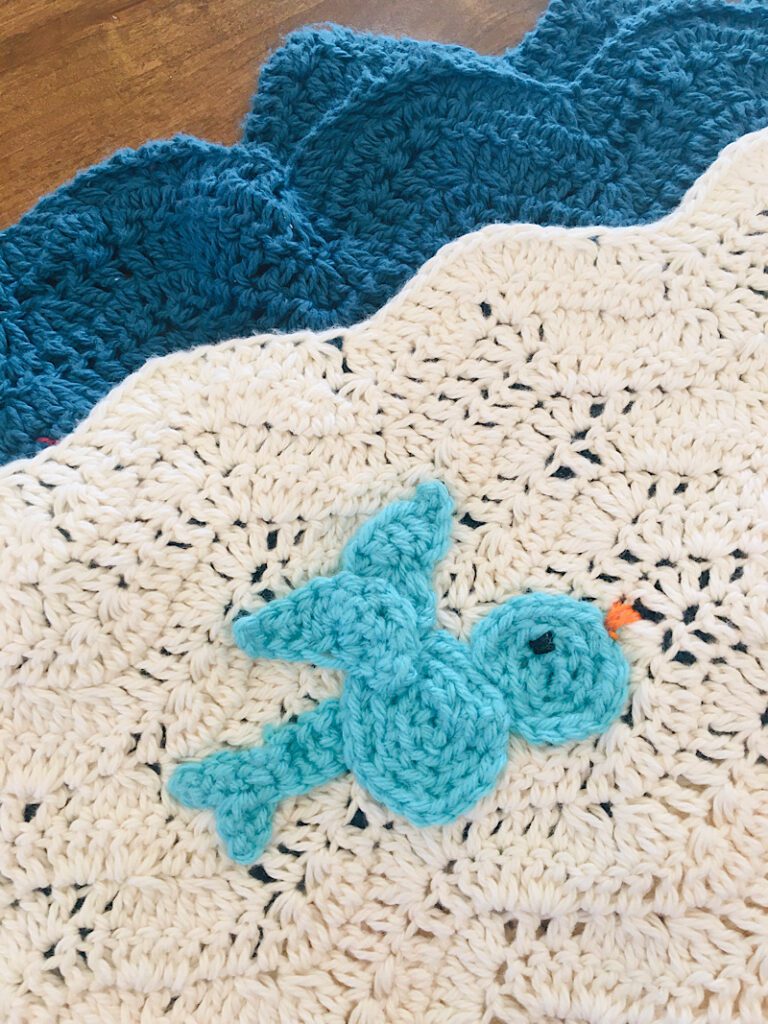
You can also crochet toys and 3 dimensional objects such as stuffed animals and baskets. Crochet is also commonly used around the hems of baby clothing and blankets as a decorative edging.
Common Crochet Tools
- Crochet Hook
- Yarn
Pros of Crochet
- Crochet designs can be very simple or very complicated
- Crochet can be quick to do once you practice holding the thread and reading patterns
- Crochet is a very mobile craft, my mother in law crocheted us a blanket while on an airplane!
Cons of Crochet
- If you make a mistake and notice It later on, you would have to undo your entire work to fix it and start over.
- Crochet can make your hands achy when you are first starting out and learning to hold the correct tension
- Crochet requires decent fine motor capabilities
What is Embroidery?

Embroidery is an art that uses a needle and thick floss or thread to embellish and decorate textiles. Embroidery can be done by hand or by machine, with or without an embroidery hoop.
Applications of Embroidery
Embroidery is a great way to add extra personalization or decoration to a finished product, such as adding a company logo to a sweatshirt, a design to a shirt pocket, or a monogram to a towel set.
Hand embroidery is also used to make artworks such as embroidered tapestries or wall hangings. By using multiple colors of embroidery floss and detailed patterns, you can embroider very detailed scenes on fabric.
Common Embroidery Tools
- Embroidery Hoop
- Embroidery Needles
- Embroidery Floss
Pros of Embroidery
- Add creative embellishments to clothing, towels, backpacks
- Make embroidered wall art
- Personalize gifts by adding embroidered monograms
Cons of Embroidery
- As with sewing, to hand embroider you must be able to thread a needle. However, an embroidery needle has a larger eye than a sewing needle to accommodate the embroidery floss which is thicker than thread, which may make it easier to thread.
- Home embroidery machines can be expensive
Which is easier?
There is no real way to measure which of these four needle arts is the easiest. They can each be quickly learned by beginners, and they all also have advanced techniques that take practice to master.
As someone who has done them all, I personally favor machine sewing (could you tell!) due to it’s speed. I do think sewing can be easy to learn, if you start with very basic patterns and techniques.
But, experienced knitters and crochet-ers can work very quickly as well once they get into the rhythm of making their stitches and loops.
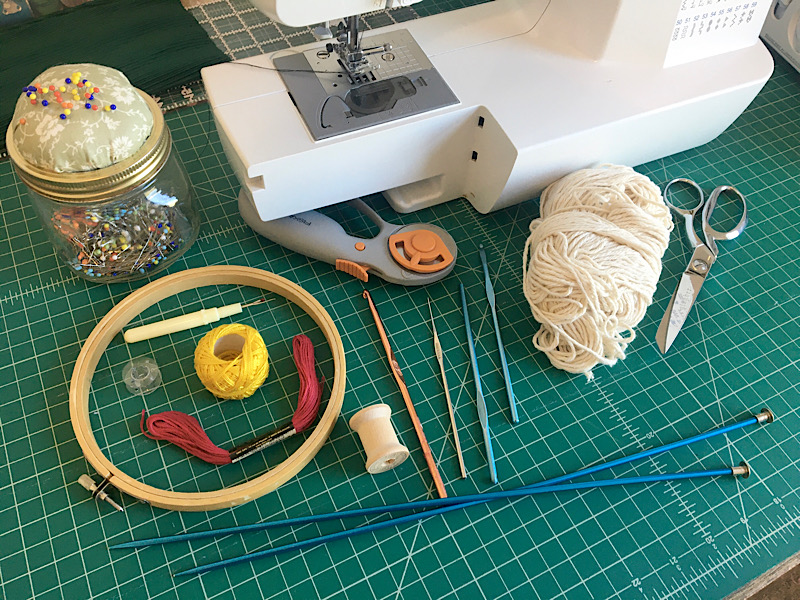
Conclusion
There you have it! A thorough comparison of sewing, knitting, crocheting, and embroidery. Many similarities between these needle crafts, but also many major differences.
Any other specific questions about these needle arts? I will do my best to answer them below!
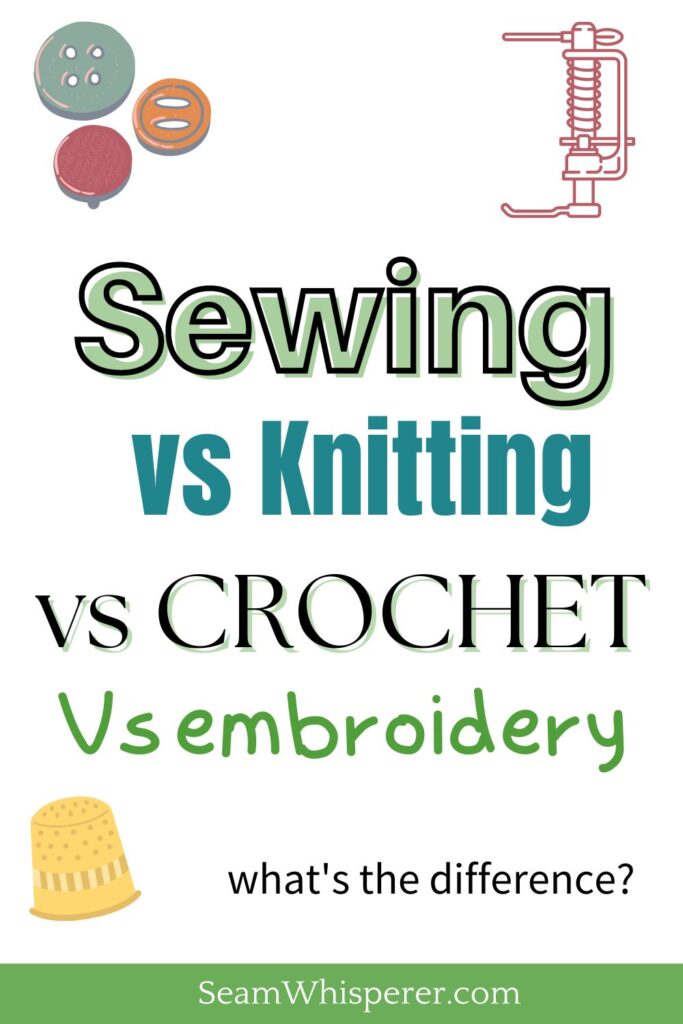


You know, my older sister’s new apartment is shaping up to be quite the boho paradise, and she’s got this wall that’s just begging for a splash of color and creativity. So, she’s been on the hunt for a one-of-a-kind artwork embroidery that can capture her free-spirited vibe. I swear, every time I visit, she’s showing me different designs and brainstorming how it’ll tie her whole space together – it’s become her latest obsession! She will agree with you that embroidery is a terrific method to further personalize or embellish a final product.